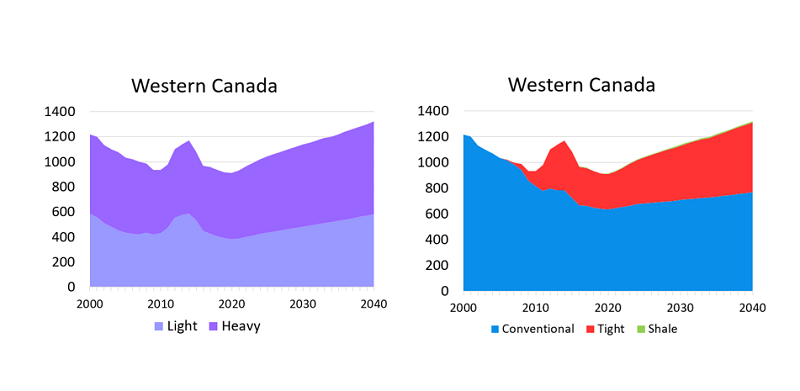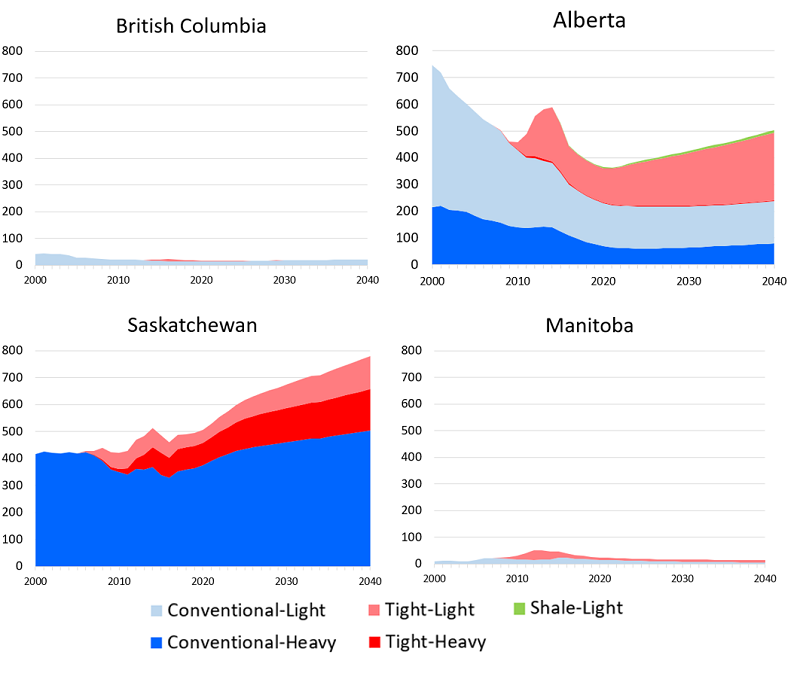Market Snapshot: Increasing western Canadian non-oil sands oil production varies by province
Release date: 2018-02-28
Oil prices have been significantly lower in the last couple of years compared to the early 2010s. This has led to a decline in total non-oil sands oil production. With prices projected to gradually increase, both total heavy and total light oil productionFootnote 1 are projected to increase after 2020. Likewise for conventional, tight, and shale oil production. However, not all provinces will see growth, and variations exist between those that do.
Oil Production in Western Canada by Class and Type (Mb/d)

Source and Description
Source: Canada’s Energy Future 2017 Supplement: Conventional, Tight, and Shale Oil Production
Description: There are two stacked area graphs. One graph breaks down the Reference Case projection for western Canadian conventional, tight, and shale oil production by province, by class of oil, and by type of oil. Total western Canada light oil production is projected to increase from 448.74 thousand barrels per day (Mb/d) in 2016 to 580.16 Mb/d in 2040. Total western Canada heavy oil production is projected to increase from 519.20 Mb/d in 2016 to 740.75 Mb/d in 2040. Another graph shows that total western Canada conventional oil is projected to increase from 668.09 Mb/d in 2016 to 767.10 Mb/d in 2040. Total western Canada tight oil production is projected to increase from 298.36 Mb/d in 2016 to 544.14 Mb/d in 2040. Total western Canada shale oil production is projected to increase from 1.50 Mb/d in 2016 to 9.67 Mb/d in 2040.
Northeastern British Columbia (B.C.) oil production is all light oil, with conventional oil making up the majority. While B.C. has large shares of Canadian natural gas production and resources (see Canada’s Energy Future 2017 Supplement: Natural Gas Production), it does not have very much oil production.
The majority of non-oil sands production in Alberta has and will continue to be light oil. Most of the production growth over the projection period is from west-central parts of the province. As horizontal drilling and multi-stage hydraulic fracturing advanced over the last decade, tight oil production increased. It is projected to continue to make up a larger share.
In 2016, heavy oil made up 54% of all production in western Canada, and this number is projected to climb to 59% by 2021 with the ramp-up of Saskatchewan thermal heavy oil projects. Heavy conventional oil makes up the majority of Saskatchewan production and grows substantially over the projection period. This growth is because of advancements in employing steam assisted gravity drainage recovery to heavy oil fields. Tight oil production will also continue in the southwest and southeast parts of the province.
Manitoba production is entirely light oil. Production will continue to decline in the medium term then flatten out later in the projection period as prices rise and stay high enough for new production to keep pace with production declines from existing wells.
Oil Production by Province, Class, and Type (Mb/d)

Source and Description
Source: Canada’s Energy Future 2017 Supplement: Conventional, Tight, and Shale Oil Production
Description: There are four stacked area graphs. One for British Columbia, Alberta, Saskatchewan, and Manitoba. The British Columbia graph shows light conventional oil is projected to increase from 15.42 Mb/d in 2016 to 21.03 Mb/d in 2040. British Columbia light tight oil is projected to decrease from 7.66 Mb/d in 2016 to 0.07 Mb/d in 2040. The Alberta graph shows heavy conventional oil is projected to decrease from 110.97 Mb/d in 2016 to 79.87 Mb/d in 2040. Alberta heavy tight oil is projected to decrease from 4.46 Mb/d in 2016 to 3.14 Mb/d in 2040. Alberta light conventional oil is projected to decrease from 189.44 Mb/d in 2016 to 157.36 Mb/d in 2040. Alberta light tight oil is projected to increase from 138.97 Mb/d in 2016 to 254.20 Mb/d in 2040. Alberta light shale oil is projected to increase from 1.50 Mb/d in 2016 to 9.67 Mb/d in 2040. The Saskatchewan graph shows heavy conventional oil is projected to increase from 328.89 Mb/d in 2016 to 503.01 Mb/d in 2040. Saskatchewan heavy tight oil is projected to increase from 74.89 Mb/d in 2016 to 154.73 Mb/d in 2040. Saskatchewan light conventional oil is less than 0.01 Mb/d. Saskatchewan light tight oil is projected to increase from 55.67 Mb/d in 2016 to 122.40 Mb/d in 2040. The Manitoba graph shows light conventional oil is projected to decrease from 23.37 Mb/d in 2016 to 5.83 Mb/d in 2040. Manitoba light tight oil is projected to decrease from 16.71 Mb/d in 2016 to 9.61 Mb/d in 2040.
See the Board’s latest report on conventional, tight, and shale oil production for additional projection details.
- Date modified:
